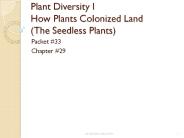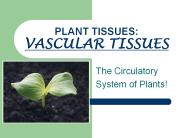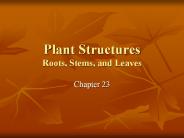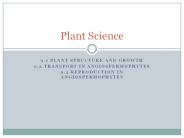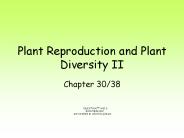Vascular Plant Structure PowerPoint PPT Presentations
All Time
Recommended
Plant Diversity I How Plants Colonized Land (The Seedless Plants) Packet #33 Chapter #29 * * * * * * * * * * * * * * * * * * * * * * * * * * * * SEEDLESS VASCULAR ...
| PowerPoint PPT presentation | free to download
Title: Plant Notes Day 1 Author: hkl16561 Last modified by: Robin Berry Created Date: 3/27/2003 7:10:56 PM Document presentation format: On-screen Show (4:3)
| PowerPoint PPT presentation | free to view
PLANT STRUCTURE & DEVELOPMENT Chapter 35 Leaves Stomata interrupts the underside of the leaf Flanked by guard cells open/close the stomata Ground tissue is in ...
| PowerPoint PPT presentation | free to download
Chapter 35 Plant Structure, Growth, and Development * Figure 35.18 Leaf anatomy. * * * Figure 35.10 Exploring: Examples of Differentiated Plant Cells * * Figure 35.10 ...
| PowerPoint PPT presentation | free to download
Seedless Vascular Plants Plants with a vascular system but no seeds Seedless Vascular Plants Phylum Pterophyta Phylum Lycophyta Phylum Sphenophyta Phylum Psilophyta ...
| PowerPoint PPT presentation | free to download
Plant Structure and Growth
| PowerPoint PPT presentation | free to download
Chapter 28 Plant Structure and Growth
| PowerPoint PPT presentation | free to view
Plant Structure and Growth Chapter 35
| PowerPoint PPT presentation | free to view
Plant Structure and Tissue http://www.howe.k12.ok.us/~jimaskew/
| PowerPoint PPT presentation | free to view
PLANT STRUCTURE AND FUNCTION D Jones Plant Cell Types parenchyma metabolism storage contain plastids that store store starch ...
| PowerPoint PPT presentation | free to download
Plant Tissue Systems Meristematic Tissue: This is growth tissue where cell division and enlargement occur and is found near the tips of roots and stem buds.
| PowerPoint PPT presentation | free to view
Plant Structure and Function Is It a Stem, Leaf, Root, Flower, Fruit or Seed? Fruit/Vegetable Part of Plant Broccoli Cabbage Carrot Celery Stalk Corn Kernel Garlic ...
| PowerPoint PPT presentation | free to view
Plant Structure. Roots, stems, leaves, flowers, and fruits make up the plant body ... Waxy cuticle on surface. Typically nonphotosynthetic and transparent ...
| PowerPoint PPT presentation | free to view
Chapter 31 Plant Structure, Reproduction, and Development
| PowerPoint PPT presentation | free to view
Plant Structure, Growth and Transport Chapters 35, 36 & 39 (in brief) Biology Campbell Reece Structure of Seed Plants 3 organs roots, stems, & leaves ...
| PowerPoint PPT presentation | free to view
Flowers. Reproductive Organs, usually dependent on pollination naturally by insects. ... Sepals Calyx (collective) green leaf-like structures, encase flower in bud. ...
| PowerPoint PPT presentation | free to view
Plant Structure and Growth Chapter 35
| PowerPoint PPT presentation | free to download
Flowers. Reproductive Organs, usually dependent on pollination naturally by insects. ... Sepals Calyx (collective) green leaf-like structures, encase flower in bud. ...
| PowerPoint PPT presentation | free to view
Plant Structure, Growth, and Development ...
| PowerPoint PPT presentation | free to view
Transport between roots and leaves (via vascular tissue, phloem and xylem ... XYLEM Carries water and dissolved nutrients from the soil, from the roots, into ...
| PowerPoint PPT presentation | free to view
Non-Vascular Plants Evolution of Land Plants Land plants evolved from green algae The green algae called charophyceans are the closest relatives of land plants ...
| PowerPoint PPT presentation | free to view
Plant Structures Roots, Stems, and Leaves Acton Science Mr. LeBlanc
| PowerPoint PPT presentation | free to view
PLANT STRUCTURE & DEVELOPMENT Chapter 35 Lateral Meristems Secondary growth Growth in the thickness of the shoot or root 2 Types Vascular Cambium Adds layers of ...
| PowerPoint PPT presentation | free to view
Vascular and Nonvascular Plants Nonvascular Plants Do not have a vascular system (xylem and phloem). Water and nutrients simply move through the plants body cell ...
| PowerPoint PPT presentation | free to view
Plant Structure, Growth, and Development Introduction The Angiosperm Body Plant Growth Introduction to Modern Plant Biology Molecular biology is identifying crucial ...
| PowerPoint PPT presentation | free to download
PLANT TISSUES: VASCULAR TISSUES The Circulatory System of Plants! The Vascular System: For plants to survive, they must take in nutrients & water from environment ...
| PowerPoint PPT presentation | free to download
Plant Science 9.1 PLANT STRUCTURE AND GROWTH 9.2 TRANSPORT IN ANGIOSPERMOPHYTES 9.3 REPRODUCTION IN ANGIOSPERMOPHYTES Control of Plant Growth Cells on the darker side ...
| PowerPoint PPT presentation | free to download
What is a Plant? with Plant Diversity Chapter 21 & 22 What is a plant? Multicellular eukaryote Produce their own food through photosynthesis Have thick cell walls ...
| PowerPoint PPT presentation | free to view
Chapter 29 Plant Diversity I: How Plants Colonized Land
| PowerPoint PPT presentation | free to view
Seedless Nonvascular & Vascular Plants-Chapter 12-Section 2 Pg. 304 Nonvascular Seedless Plants All nonvascular plants are seedless meaning The plant groups in ...
| PowerPoint PPT presentation | free to view
Chapter 24 Seed Plant Structure and Growth PLANT TISSUES- Vascular plants have three tissue systems Dermal tissue forms the protective outer layer of a plant.
| PowerPoint PPT presentation | free to download
Nonvascular & Simple Vascular Plants Mosses to Ferns * * * * * * * * * * * * * * * * * * * * * * * * * * * * * * * * * * * * * * * Club Moss Sporophylls (spore cases ...
| PowerPoint PPT presentation | free to download
Characteristics and Structures of Plants SC Standards 6-2.3 6-2.4 * Plants are classified into groups based on specific structures. Plants may be classified by ...
| PowerPoint PPT presentation | free to view
Unit XI: Plant Structure and Function Plant biology, perhaps the oldest branch of science, is driven by a combination of curiosity and need- curiosity about how ...
| PowerPoint PPT presentation | free to download
Chapter 30 Plant Diversity II: The Evolution of Seed Plants * * * * * Figure 30.13 Exploring: Angiosperm Diversity * * * Figure 30.13 Exploring: Angiosperm Diversity ...
| PowerPoint PPT presentation | free to view
Sexual Life cycles Plant structure and Phylogeny The Angiosperms Outline Brief review 9. ALTERNATION OF GENERATIONS 8. PLANT EVOLUTION 7. ANGIOSPERM LIFE HIST.
| PowerPoint PPT presentation | free to view
Plant Structures Roots, Stems, and Leaves Chapter 23 23-1 Specialized Tissues in Plants Plants are as successful if not more successful than animals Seed plants have ...
| PowerPoint PPT presentation | free to download
Title: Plant Diversity - Colonization of Land Author: Jay Comeaux Last modified by: Kyle Harms Created Date: 3/10/2003 11:29:38 AM Document presentation format
| PowerPoint PPT presentation | free to view
Plant Diversity: How Plants Colonized Land The Origins of Plants Bryophytes The Origin of Vascular Plants Seedless Vascular Plants Overview Common characteristics ...
| PowerPoint PPT presentation | free to view
Vascular Systems in plants. an introduction to ... Hydrophytes have a reduced xylem component in the vascular system. ... Advanced foliage leaf, dicotyledon. ...
| PowerPoint PPT presentation | free to view
Water-conducting elements of xylem ... 35.8 Water-conducting cells of xylem. Sieve-tube members, sieve plates, ... Xylem -- vascular. Phloem -- vascular ...
| PowerPoint PPT presentation | free to view
Chapter 23: Plant Structures Roots, Stems, Leaves A. 4 MAJOR PLANT ORGANS (ANGIOSPERMS) 1. LEAF PHOTOSYNTHESIS 2. STEM TRANSPORT, SUPPORT OF LEAVES & FLOWERS ...
| PowerPoint PPT presentation | free to download
At the root hairs structures that increase surface area to aid in absorption of ... I understand that the tuber allows the potato plant to store food, but what kind ...
| PowerPoint PPT presentation | free to view
Plant Structure and Growth 5th Grade Investigation 2 Vascular Plants Video Notes Question 1 What do all plants have in common? Question 1 Answer All plants are ...
| PowerPoint PPT presentation | free to view
Plant Structure and Growth Chapter 35 Plants with vascular tissue have 3 structures - roots, shoots, leaves. 2 groups of angiosperms, monocots and dicots, differ in ...
| PowerPoint PPT presentation | free to download
Plant Structure and Growth. Figure 35.1 A comparison of monocots ... Palisade parenchyma. Spongy parenchyma (contains veins xylem and phloem) Lower epidermis ...
| PowerPoint PPT presentation | free to view
Plant Science 9.1 PLANT STRUCTURE AND GROWTH 9.2 TRANSPORT IN ANGIOSPERMOPHYTES 9.3 REPRODUCTION IN ANGIOSPERMOPHYTES Control of Plant Growth Cells on the darker side ...
| PowerPoint PPT presentation | free to download
The main body of the portion above ground of a tree, shrub or herb. ... Adventitious Roots. Roots that develop from other plant parts. Ex: roots on stem cuttings ...
| PowerPoint PPT presentation | free to view
The roots make up the root system in which allows the plant to absorb ... The vascular cambium produces secondary vascular tissues (secondary xylem and phloem) ...
| PowerPoint PPT presentation | free to view
Structures and Functions in Plants Roots, Stems, and Leaves Specialized Plant Cells There are three types of cell found in plants that are arranged differently in ...
| PowerPoint PPT presentation | free to view
Plant Reproduction and Plant Diversity II Chapter 30/38 Seed plants - vascular plants that produce seeds. 3 adaptations that seed plants have: 1Gametophyte more ...
| PowerPoint PPT presentation | free to download
Lecture #4 Plant Structure, Growth And Development Image the Angel Oak Key Concepts: What is a kingdom? Why study plants? What makes a plant a plant?
| PowerPoint PPT presentation | free to download
Within seed plants, what are the two main types? ... waxy cuticle (bacteria and fungi) trichomes. spines, thorns, and prickles. others ...
| PowerPoint PPT presentation | free to view
The green algae called charophyceans are the closest ... Seeded Vascular Plants. Gymnosperms- conifers, cycads, and ginkgo. Angiosperms- flowering plants ...
| PowerPoint PPT presentation | free to view
Resource Acquisition and Transport in Vascular Plants * * Figure 36.16 Some xerophytic adaptations. * * * * * Figure 36.17 Loading of sucrose into phloem.
| PowerPoint PPT presentation | free to view

